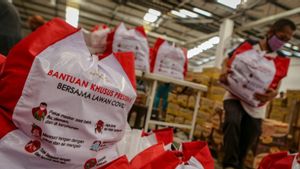JAKARTA - The Ministry of Finance (Kemenkeu) said that the value of the trade surplus in the November 2021 period, which amounted to 3.51 billion US dollars, was a surplus for 19 consecutive months.
Head of the Fiscal Policy Agency (BKF) of the Ministry of Finance, Febrio Kacaribu, said that if the accumulated trade balance surplus from January to November 2021 would reach 34.32 billion US dollars.
“This high surplus is supported by high export value. The cumulative export value (Jan-Nov 2021) is the highest export value since at least the last 2000 period," he said in a press statement, quoted on Thursday, December 16.
According to Febrio, the positive book on trade in Indonesian goods abroad cannot be separated from the increase in demand from foreign markets.
"The trend of increasing exports continues, driven by both increases in main commodity prices and volumes," he said.
Febrio noted that manufacturing and mining products recorded quite high growth. On the other hand, imports also showed an increasing trend, indicating continued strengthening of national economic activity.
"The increase in imports can be seen from all sectors, both oil and gas and non-oil and gas sectors and based on their use, such as consumer goods, raw/auxiliary materials, and also capital goods," he said.
In detail, the total export value in November 2021 reached 22.84 billion US dollars, an increase of 49.7 percent on an annual basis (year-on-year/yoy) or 42.6 percent throughout the current year (year-to-date/ytd).
The non-oil and gas sector contributed up to 94.17 percent of total exports or US$21.51 billion. The export value is dominated by the manufacturing industry sector with a contribution of 71.2 percent.
SEE ALSO:
Other sectors that also contributed significantly were the mining sector, which grew by 146.9 percent yoy.
"High export performance was driven by key commodities such as CPO, iron and steel, coal and tin," said Febrio.
In terms of imports, total imports in November 2021 were recorded at 19.33 billion US dollars, up 52.62 percent yoy.
This growth was driven by non-oil and gas imports which reached 16.30 billion US dollars or grew by 40.79 percent yoy. In terms of usage, the largest imports came from imports of raw/auxiliary materials (74.14 percent), followed by imports of capital goods (15.51 percent) and consumption goods (10.35 percent).
"The portion of imports, which are mostly imports of raw materials and capital goods, shows the dynamics of activity in the production sector which has been active," closed Febrio.
The English, Chinese, Japanese, Arabic, and French versions are automatically generated by the AI. So there may still be inaccuracies in translating, please always see Indonesian as our main language. (system supported by DigitalSiber.id)
















